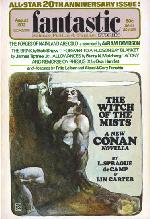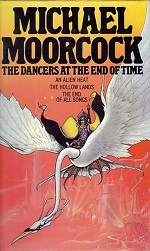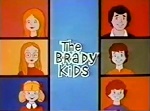|  
 
 
 
 
 | | | |  | | “Forever to a Hudson Bay Blanket”
by James Tiptree, Jr.
First publication: Fantastic, Aug 1972

At 75, heiress Loolie Aerovulpa travels back to her nubile teenaged body to throw herself at her one true love, Dovy Rapelle. “Do you like me? I’m attractive, am’t I?” She opened the blanket to look at herself. “I mean, am I attractive to you? Oh, Dovy, s-say something! I’ve come so far, I chartered three jets, I, I,—Oh, Dovy d-darling!” “Do you like me? I’m attractive, am’t I?” She opened the blanket to look at herself. “I mean, am I attractive to you? Oh, Dovy, s-say something! I’ve come so far, I chartered three jets, I, I,—Oh, Dovy d-darling!” 
| |
| | | | |

 
 
 | | | | 



| | The End of Time Series
by Michael Moorcock
First book: Oct 1972

Every now and then, a time traveler finds his way to the End of Time where a small group of decadent immortals manipulate matter and energy with power rings.- 1. An Alien Heat, Oct 1972 Dancer Trilogy 1
- 2. The Hollow Lands, 1974 Dancer Trilogy 2
- 3. Pale Roses, 1974 in New Worlds 7
- 4. The End of All Songs, Jul 1976 Dancer Trilogy 3
- 5. White Stars, Mar 1975 in New Worlds 8
- 6. Ancient Shadows, Nov 1975 in New Worlds 9
- 7. Legends from the End of Time, 1976
aka Tales from the End of Time includes 3,5,6
- 8. Transformation of Miss Mavis Ming, Feb 1977
aka A Messiah at the End of Time Expands Constant Fire
- 9. The Dancers at the End of Time, 1981 includes 1,2,4
- 10. Elric at the End of Time, Sep 1981 in Elsewhen
- 11. The Murderer’s Song, Aug 1986 in Tales/Forbidden Planet
 Our time travellers, once they have visited the future, are only permitted (owing to the proerties of Time itself) at best brief returns to their present. Our time travellers, once they have visited the future, are only permitted (owing to the proerties of Time itself) at best brief returns to their present. 
| |
| | | | |

 
 
 | | | | 

| | The Brady Kids
directed by Hal Sutherland
First time travel: 16 Dec 1972

The kids, sans Alice and parents, starred in their own cartoon show with magical adventures including at least one time-travel incident where Marlon the wizard bird changes places with Merlin—all directed by Hal Sutherland, the soon-to-be director of the animated Star Trek. Boys: ♫Meet three sisters, Boys: ♫Meet three sisters,
Girls: Now meet their brothers,
Marcia: Greg’s the leader and a good man for the job.
Jan: There’s another boy, by the name of Peter,
Cindy: The youngest one is Bob.
Boys: See our sisters: They’re all quite pretty.
Greg: First there’s Marcia, with her eyes a sparklin’ blue.
Peter: Then there’s Jan, the middle one, who’s really groovy,
Bobby: And sister Cindy, too.
Boys: Let’s get set now, for action and adventure, as we see things we never saw before.
Girls: We’ll meet Mop Top and Ping and Pong, the pandas, and Marlon who has voices by the score.
All: The Brady kids, the Brady kids, it’s the world of your friends the Brady kids!♫ 
| |
| | | | |

 
No Time Travel. Move along. |
Green Darkness by Anya Seton, Nov 1972 [reincarnation ]

| |     |